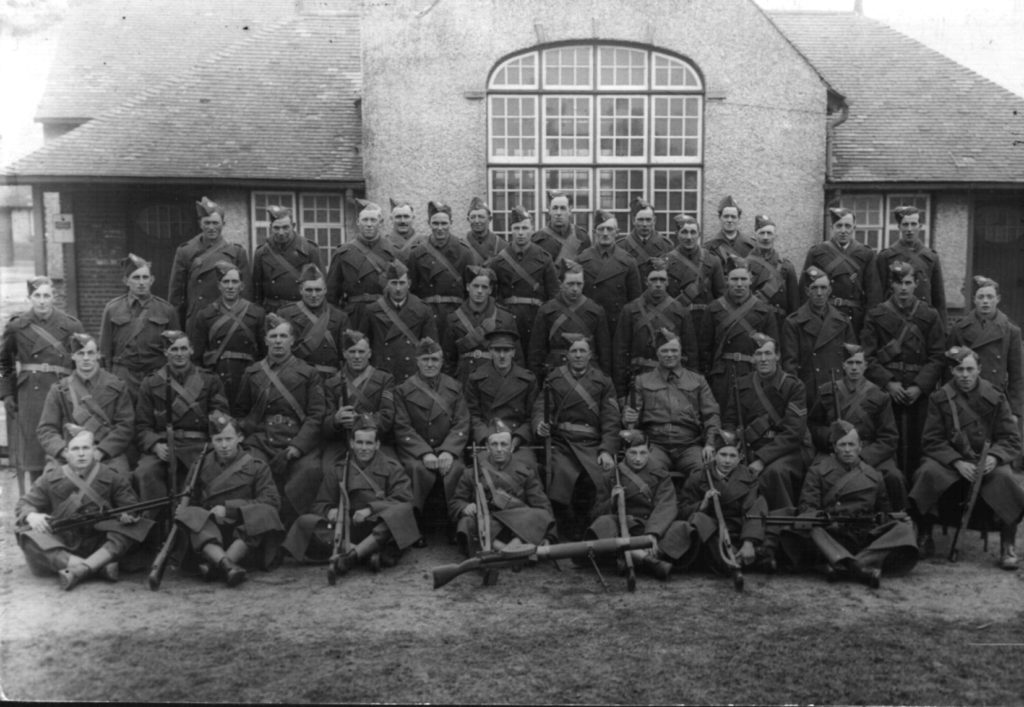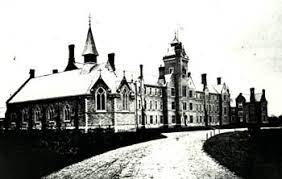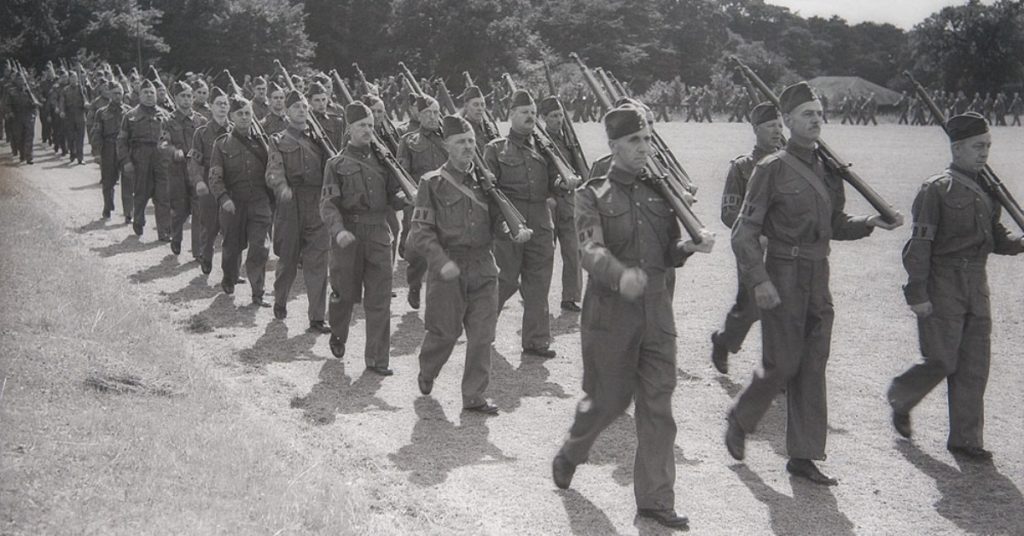Several years ago, I wrote a blog post about two officers from the Ramsey Home Guard, Captain William Henry Newton and Lieutenant John Curedale. Both officers were called upon to apprehend German spy Josef Jakobs who had landed by parachute on the evening on 31 January 1941. Lying in a potato field all night, just southeast of Dovehouse Farm on the outskirts of the village of Ramsey, Josef had been in considerable pain, having injured his ankle while leave the German aircraft. After shooting off a pistol to attract the attention of some passing farmers on the morning of 1 February, word reached the ears of the Huntingdonshire Constabulary in Ramsey. Inspector Jaikens passed word of the spy to the Home Guard who dispatched Newton and Curedale.
Newton would testify at Josef’s court martial several months later about the events surrounding Josef’s capture, but Curedale was unavailable to testify having been transferred from the Home Guard to an active duty position with the Royal Armoured Corps. I admit to coming up empty while trying to research more information about Newton and Curedale in 2015, but… had another go at it last week and found a few tidbits of information thanks to the 1939 National Registration which, conveniently, has Newton and Curedale living a few doors down from each other! Here’s what I discovered.
Lieutenant John Curedale
According to the 1939 National Registration, John Curedale was living at 70 Biggin Lane in the village of Ramsey. He was born on 13 April 1908 making him 31 years old at the time of the registration. His occupation was Fertilizer Manufacturer Representative, which jives with what little information we have on him from the MI5 files. He also served in the Observer Corps (Certificate No. 3829), a civil defence organization that tracked enemy aircraft over England.
At the time of the registration, September 1939, Curedale was living with his wife, Florence P. Curedale who was a couple of years younger than him, having been born on 24 March 1910. Florence was a housewife (unpaid domestic duties) but also served as a Red Cross Nurse. The couple had also opened their home to two evacuated high school teachers, Maud and Rose Sharman. The two teachers were both single, presumably siblings and aged 60 and 57 years old respectively. I did a bit of digging and it looks as if they were originally from Hackney, London, so likely evacuated during the Blitz.
With John’s birth date, courtesy of the 1939 National Registration, we’re able to find quite a bit more information about him.
John was born in the village of Ramsey to John Curedale (1875-1929) and Annie Olive Southwell (1877-1942). According to the 1911 census, John Sr. had been born in Oldham Lancashire and worked as a Chemical Manure salesman (likely an older term for fertilizer salesman). The couple had a daughter as well, Betsy Louise Curedale, born 15 September 1906, in Huntingdon. Betsy married William John Whitsed in 1934 and passed away in 1995 in Peterborough. In 1911, the family had a servant, a 15 year old girl named Ida May Binder born in Peterborough. John Sr. must have done fairly well for himself to be able to take on a servant. The family was living at 5 Station Road. I’m not sure if that is a posh area of Ramsey or not, but Google StreetView shows some detached and semi-detached houses behind Ramsey Junior School.
I haven’t been able to find anything on John Jr.’s early life and he next pops up in the records in 1936 when he married Florence Percie Garner in Peterborough. The couple had no children in the 1939 National Registration and I have been unable to find any subsequent births of Curedale children with Garner as the mother’s maiden name. John’s sister, Betsy, on the other hand had two children.
John likely signed up with the Home Guard in late 1939 or 1940 but his service was short-lived. He was involved in the apprehension of Josef Jakobs in January 1941 but, by June 1941, had transferred to an active duty position with the regular army. By the time Josef was court martialed in August 1941, John was serving with the 55th Training Regiment, Royal Armoured Corps, 68 Troop, C Squadron, residing in the Elles Barracks in Farnborough, Hampshire.

(From Ramsey and District website)
Ancestry provided one more tidbit of information, noting that John served in the Tank Corps (Black Caps) as a Sergeant during the Western Desert Campaign. I did a bit of digging and the Royal Tank Regiment (part of the Royal Armoured Corps) did indeed wear black berets (they showed less oil stains). Interestingly, when uniforms were issued to the Royal Observer Corps (which John was part of in 1939), there was a surplus of Royal Armoured Corps black berets which were shared with the unit.
Beyond that, all we know about Curedale is that he passed away in 1984 in Ipswich at the age of 75. His wife, Florence, had predeceased him, passing away in 1978 in Blyth, Suffolk at the age of 68.

Captain William Henry Newton
As noted above, William Henry Newton was living just a few doors down from Curedale, at 67 Biggin Lane. I had a look, and current street numbers only go up to 47 on Biggin Lane, and those houses look rather new. Biggin Lane is just north of the former site of RAF Upwood which makes me wonder if the area was redeveloped after the war.
According to the 1939 National Registration, William was born 2 June 1898, making him a whole 28 days older than German spy Josef Jakobs (born 30 June 1898). In 1939, William was an Auctioneer Valuer and Estate Agent who was also registered with the Army Officers Emergency Reserve. William would have been 41 years old at the time of the 1939 National Registration, but I found no evidence that he was transferred to active duty during the war. His son, on the other hand, joined the Oxford & Buckinghamshire Light Infantry (see below).
In 1939, William was married to Gladys F. Newton, born 29 November 1897. Five other people lived in the household: Marianne Newton (born 6 June 1863), a 76 year old widow and presumably a relation of William (his mother, see below). A 73 year old, Emily Allen (single) lived in the house as a companion to Marianne, perhaps in a care-taking capacity. There was also Hedvig M[eta] Pugh-Davies, a 45 year old married woman whose occupation was unpaid domestic duties. She was a native of Denmark and had married Cecil Frederick Pugh-Davies in 1920. Cecil was a Flight Officer with the RAF and may have been stationed at RAF Upwood. The 1939 register also has two closed records, possibly the children of William and Gladys (see below), or perhaps the children of Hedvig and Meta.
There are an awful lot of William Henry Newton’s in the UK, but the 1898 birth index for William noted that his full name was: NEWTON, William Henry M.W.O. It took a while but… I tracked down a family tree for William and his full name is… William Henry Mordaunt Wells Orriss Newton. The mind boggles at such a name…
William was born 2 June 1898 in Ramsey, Huntingdonshire to Mordaunt Wells Newton (1859-1929) and Marianne Orriss (1863-1945). According to the 1911 census, Mordaunt was a draper, dressmaker and grocer while his wife, Marianne, assisted him with the business (this is the same Marianne who was living with William and Gladys in 1939). Our young man William is listed as “Henry” and, being 12 years old, was at school. Emily Allen (Marianne’s companion in 1939) was already living with the family in 1911 (and 1901) in the capacity of assistant dressmaker. The family also had a 20 year old servant named Annie Knighton,
William entered Bedford Middle Class Public School in 1911. He was assigned to Cowper House and left the school in 1915. At the time, his parents were living at 20 Great Whyte in Ramsey, now a Lloyd’s Pharmacy. Interestingly, Robin William George Stephens (future commandant of MI5’s Camp 020) attended Bedford Grammar School from 1907 to 1910. It would seem, however that the two schools are quite different. Newton attended the public school while Stephens attended the independent school.

Several years later, in 1921, William married Gladys Francis How in Paddington, London. The couple had two children in rapid succession, Henry James Wells Newton, born 5 May 1922 in Ramsey and Elizabeth A.W. Newton, born 4 April 1924 in Ramsey. Elizabeth married Denis Charles Coleman in 1946 and two years later, the couple travelled to Kenya aboard the Klipfontein (Holland Africa Line). They may have been visiting Elizabeth’s parents, William and Gladys (see below). Elizabeth passed away in 1964 at the age 40 years and I haven’t tried to track her husband or children. The life of her brother Henry, on the other hand, provides us with a bit more family information, including a few tidbits about William.
Henry James Wells Newton
While I thought that Henry James would be included in his parents’ household in the 1939 National Register, he also appears in the register of Kings School, The Precanets, Canterbury (birth date is a match). He would have been 17 at the time. It is possible that he was registered in two places (home and school), or perhaps the two closed registers are Hedvig’s children. It isn’t clear if Henry graduated from Cambridge for, upon the outbreak of war, he seems to have enlisted and attended one of the officer training schools, perhaps the Royal Military College at Sandhurst.
According to a notice in The Gazette in December 1941, Henry James Wells Newton (219882) was promoted from Cadet to 2nd Lieutenant with the Oxford and Buckinghamshire Light Infantry. A WW2Talk forum has some regimental diaries from the 1st Battalion of the Ox and Bucks Light Infantry, and mentions Henry’s name. From this, we know that Henry landed on the coast of Normandy in late June 1944. On 8 July, the diary notes that “Enemy mortaring was again on the reduced scale experienced on 7th July. During the night, Lieutenant HJW Newton led a further recce patrol to observe the area Quedeville 892643, and again enemy activity was reported.” Beyond that, there is no further mention of Henry in the diaries. On the other hand, I did find a casualty list from the summer of 1944 which listed Henry as having been wounded, but there is no date for the wound, simply D.N.R. (date not recorded). Although… another list requests that his entry be deleted as it was listed in error. It is likely, however, that Henry fought with his regiment through Western Europe until war’s end.
Henry’s military career continued after the war and a 1947 Regimental Diary of the Ox and Bucks noted that on 30 January of that year, Captain H.J.W. Newton rejoined the Regiment from privilege leave and resumed his duties as Adjutant. From the narrative description of the diary, it seems that the regiment spent time in Trieste (an Italian port, on the northeast corner of the Adriatic). The regiment was then deployed to Pola in Yugoslavia (just south of Trieste). After three months on the shores of the Adriatic, the regiment was next deployed to Luneberg, just south of Hamburg, as part of the British Army of the Rhine (B.A.O.R.). On 27 September 1947, the regimental diary noted that “Capt. A.C. Eyre assumes the duties of Adjutant in the absence of Capt H.J.W. Newton on leave and duty”.
Later that same year, on 19 December 1947, Henry’s engagement to Catherine Margaret (Bunty) nee Bonsor was announced in the West Sussex County Times. Henry was listed as the only son of Mr. and Mrs. W.H. Newton of Biggin, Ramsey.
Ten days later, on 29 December 1947, the regimental diary noted that Capt. H.J.W. Newton assumed command of A Coy while vice Major H.P. Patterson was on leave. Newton would hold the command until early August of the following year, when Patterson rejoined the regiment. It would appear that the Battalion was stationed in Hanover for at least part of the time, taking part in B.A.O.R. exercises.
Henry and Catherine were married on 3 April 1948 at St. Margaret’s Church in Warnham, Sussex. According to that newspaper notice, Henry was a Captain with the Oxford and Buckinghamshire Light Infantry. His parents were residents of Kitale, Kenya at the time. The fact that Henry’s sister, Elizabeth, travelled to Kenya that same year makes me think that she might have been visiting her parents in Kenya.
A few months later, on 26 August, Henry was posted from the Regiment to assume the appointment of staff captain (A.L.O.). The A.L.O. is a bit of a mystery and could be Air Liaison Officer, Artillery Liaison Officer or even Australian Liaison Officer.
While stationed in Germany, Henry and Catherine welcomed a daughter into their lives on 28 February 1950. Sara Elizabeth Wells Newton was born at the Military Hospital in Hanover. It seems clear that Henry’s regiment moved around a fair bit during the post war period! Almost two years after the birth of Sarah, the couple welcomed another daughter into their lives. Nicola Jane Wells Newton was born on 25 December 1951 in Hailsham, Sussex.
I found several transcripts of the Regimental Chronicles for the Ox and Bucks on Scribd. They provide brief snapshots into Henry’s military career. On 12 January 1953, Captain H.J.W. Newton was “appointed O.C. [Officer Commanding] B Company. O Group carried out a recce of Abu Sultan 9 Base Ammunition Depot. [in the Suez Canal area of Egypt]” This would have been around the same time that Lt. Col. Robin W.G. Stephens was stationed in Egypt as the head of S.I.M.E. (Security Intelligence Middle East). A week later, on 19 January, Newton was promoted to T/Major. A few months later, the regiment left Egypt for Southampton and was stationed at Chiseldon Camp near Swindon. Newton relinquished his T/Major on 20 May as being “surplus to the establishment”. In July, the Battalion departed for Osnabrück in Germany where married quarters were “plentiful and good”. For the first time in almost two years, husbands were again able to live with their families. It seems likely that William was joined in Germany by his wife and daughters. On 10 November, William was once again promoted to T/Major! Eventually his rank would stick…
While it’s a bit harder to track Catherine through the genealogical records, I did find a passenger list for the M/V Aureol (Elder Dempster Lines). The ship departed Liverpool on 16 May 1957 bound for the west coast of Africa. Catherine is listed as travelling to Nigeria with her two daughters. The three had the intention of making Nigeria their permanent residence (12 months or longer). This makes me wonder if Henry was stationed in Nigeria during this period, but I haven’t found any records to confirm that.
In 1960, Major Henry James Wells Newton received the MBE (Military Division) while serving with the 1st Green Jackets (43rd and 52nd). While it might appear that Henry switched regiments, such is not the case. In 1958, the Ox and Bucks Light Infantry was renamed the 1st Green Jackets (43rd and 52nd), forming part of the Green Jackets Brigade. Three years later, in 1963, Henry was promoted to Lieutenant Colonel. I also found reference to several Jamaican newspapers which, in 1965 and 1967, noted that Lt. Col. H.J.W. Newton was stationed there as part of the Jamaica Defence Force. Henry eventually retired in 1968 (age 46) and passed away in Colchester at the age of 69 (1991). He was predeceased by his wife Catherine who passed away a couple of years before him, also in Colchester.
Conclusion
If we return to the real quarry in our quest, William Henry M.W.O. Newton, we are left with some answered questions. It’s not clear what William was doing in Kenya in the late 1940s. As for his death, all we know is that he passed away in 1967, possibly overseas. As for his wife, Gladys, she passed away on 6 August 1982 in Ipswich, Suffolk.
Perhaps some relations of William Henry Mordaunt Wells Orriss Newton will be able to shed a bit more light on his life and career. I know that both of his granddaughters married in the early 1970s, so would welcome any tidbit of information.
Sources
Ancestry – genealogical records
Oxford and Buckinghamshire Light Infantry regimental diaries from WW2Forum and Scribd
Cover image – “Home Guard (Local Defence Volunteers) WW2 image” by whatsthatpicture is marked with CC PDM 1.0
